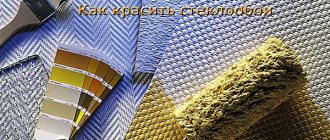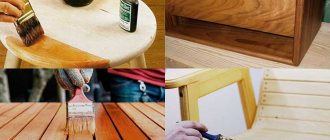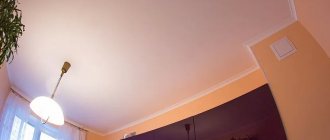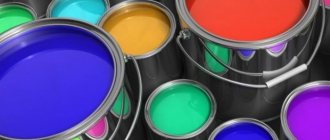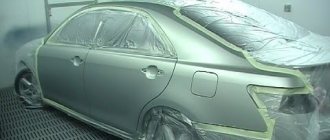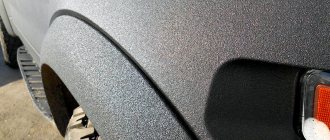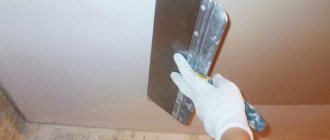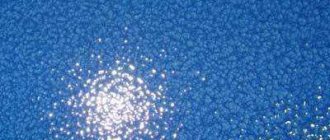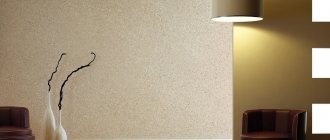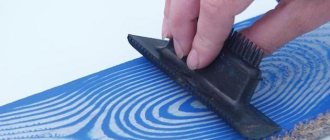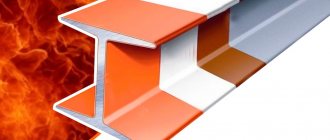What is hammer paint?
Hammer paint is a type of painting material that has ultra-durable characteristics and ease of application. It got its name because of the pattern, which is reminiscent of hand hammer chasing, thanks to which it is possible to hide defects in the painted surface.
Types of hammer paint
Initially, the material was used in factories and laboratories, where products were affected by chemical or mechanical factors, and was also used for external metal structures for durable protection against corrosion. The material contains resins, which provide these characteristics.
On average, about 100 g of enamel is used per 1 m2, depending on the method of application. The price of hammer paint for metal is high, which means that with high consumption, using the material is not a cheap pleasure.
You can apply paint using brushes, a roller, a spray gun, or ready-made from a spray can. Paint is sold in stores in finished form. Initially, the paint was made in the most common colors, but as it gained widespread popularity for decorative purposes, a wide palette of colors appeared.
The enamel is highly resistant to temperature and weather changes, rust, mechanical damage, and paint is difficult to remove from surfaces, even with the help of a solvent.
The paint is produced in several forms: aerosol - in cans; liquid - tin cans and plastic buckets. Enamel is produced only in finished form; powder form is not used due to its complex composition, and it is impossible to prepare it at home. The paint can be purchased with a glossy or matte finish. Description and instructions for use are described on the packaging. You need to buy a specific shape depending on the surface to be painted.
Hammer paint in aerosol form
Positive and negative aspects of using CM
Hammer enamel for metal effectively protects the base in any adverse weather conditions. The paint is in demand due to its qualities:
- Tolerance to temperature fluctuations and overheating. The maximum permissible high temperature for operation is +80°C. Formulations with a high threshold are produced.
- The composition is applied over rust.
- High drying speed reduces repair time.
- A coating with water-repellent properties is formed.
- Small defects on the base are masked. The detected fragment is painted over locally, while the restoration site remains invisible.
- The protective and decorative layer lasts 8 years.
- The dried layer has no toxic odor.
- The dye is used indoors and outdoors.
- Resistant to the UV rays of the sun, the color remains vibrant for a long time.
- It is possible to choose a shade for painting the surface.
- Decorating properties at a high level.
- Coating with dirt- and dust-repellent properties. Always clean surface.
- Tolerance of mechanical influences. If you hit metal with a hammer, it will become deformed. At the same time, the paint layer remains intact.
We will have to talk less about the negative aspects:
- The coating layer cannot be removed even with a strong concentrated solvent.
- Fillers make the composition thick, which makes it difficult to apply by spray.
- The material is not economical. The price is high and the consumption is high.
Compound
The composition of paints may differ in additional components that manufacturers add for marketing purposes. But the basic composition of the paints is the same.
| Component | Properties |
| Aluminum flakes | Create a hammer pattern |
| Metal powder | Creates a shiny surface |
| Glass chips | Adds texture and increases service life |
| Silicone and acrylic resins | Bonds the paint and the surface being painted. |
| Technical wax | Creates a protective layer |
The characteristics of the paint depend on the ratio of the components. And to create resistance to high temperatures, a special component is added to the enamel.
Properties and methods of paint application
The paint is applied in strict accordance with the temperature regime: from +10 to +25 degrees and humidity no more than 83%. To distribute the material use:
- brush;
- roller;
- aerosol can;
- pneumatic or air spray.
When applying, it is important to control the thickness of the applied layer, which should not exceed 100 microns (this is the optimal thickness for forming a reliable anti-corrosion layer).
Let's take a closer look at the main methods of applying paint.
Scope of application
The scope of application of the material is quite wide. This is due to durability, corrosion protection and interesting patterns. After complete drying, the enamel is safe for humans, which means it can be used for interior decoration.
You can apply paint to almost any type of surface - metal, concrete, drywall, wood, corrugated board, plastic, MDF and others.
The most popular brand of the manufacturer is Hammerite. Hammerite paint ML-165 is distinguished by its quality, long service life and dries quickly. Other well-known brands include Hamerton, Parade Z1, Molotex and Mister Hammer.
Initially, hammer enamel was used in factories and enterprises for painting metal structures, as it is resistant to temperature and weather changes, and also provides excellent protection against rust.
Heat-resistant enamel can withstand temperatures up to 300 degrees Celsius, thanks to a special component in the composition. The price of such hammer paint is slightly more expensive.
Hamerton hammer paint
Areas of paint application:
- Painting of metal structures, products and tools in production, construction, wooden objects;
- As a coloring material for metal doors, safes and furniture;
- For painting cars and their metal parts (wheels, tires, etc.);
- Used in the blacksmith industry, when painting forged objects. For painting purposes, patina with gold, copper or silver plating is used;
- For decorative and advertising solutions.
Due to the popularity of use, a wider selection of colors has appeared. Previously, there were only black, white, and gray colors. Now they produce the following colors:
- Antique Copper
- Antique Bronze
- Antique Oak
- Antique Green
- Antique Blue
- Antique Golden
- Antique Purple
- Blue-gray hammer
- Blue hammer
- Khaki hammer
- Green hammer
- Gray hammer
- Brown hammer
- Red hammer
- Silver gray hammer
- Silver black hammer
- Dark gray hammer
- Chocolate hammer
Review of popular manufacturers
The most popular compositions are:
- Hammerite. This is a very expensive substance that is highly effective. Country of origin: England. This dye effectively removes imperfections on the surface and protects it from oxidation. Also, the enamel of this brand provides protection of the base from corrosion for up to eight years, and the silicone content in it provides protection from external irritants and contaminants.
- ML 165. Designed for application on a non-greasy base. This type of dye is durable and heat resistant, but contains toxic substances.
- NTs 221. A budget option that has fairly high protective properties. This paint is intended for exclusively interior work, but it is strictly prohibited to apply it to rust.
- EP 1323 ME. Used as a primer, recommended for painting cars and various types of fences.
- Molotex. It has anti-corrosion properties, perfectly hides coating defects and provides it with protection from external negative factors.
- Delhi. It has a fairly high anti-corrosion effect and is used for application to stainless steel, non-ferrous metals, cast iron, galvanized metals.
Enamels with hammer effect are high-quality coatings that are reliable, durable, and durable. Such compositions have water-repellent, heat-resistant and anti-corrosion properties. They are easy to use and do not require special knowledge in this area to carry out painting work. They can process various substrates, with particular preference given to metal structures. The paint can be applied in various ways, so each user can choose one that is convenient for themselves.
Advantages and disadvantages
Hammer effect paint has the most important advantages - durability and impressive appearance. Other advantages of enamel include:
- Resistant to a wide range of temperatures;
- Quick-drying;
- You can paint objects without preliminary surface preparation - primer, etc.; can also be applied directly to rust;
- Resistant to water and moisture;
- Protects metal surfaces from rust for 8 years;
- Resistant to mechanical damage;
- Safe for health after complete drying;
- Resistant to direct sunlight, does not fade;
- Wide palette of colors;
- Easy to use - you can paint it yourself;
- Resistant to dry and wet cleaning, and also has the ability to repel dirt;
- Hides unevenness.
Hammer paint palette
Disadvantages of enamel:
- Paint is difficult to remove, even with a solvent;
- From unpainted old areas, rust can transfer to the paint layer;
- Difficulty in applying thick paint with a spray gun;
- High price;
- High consumption per 1m2.
Peculiarities
Hammer effect enamel has a specific structure that is very similar to metal, hence the name. Another feature of the coating is the high density of the substance; this effect significantly increases the strength of the material, but complicates application using a sprayer.
Note! Hammer enamel spreads well over rust, so the paint was originally developed to protect metal coatings from corrosion and was only gray in color. After some time, the coating began to be used for decorative purposes, and the color range became more diverse.
Application methods
Paint can be applied to many surfaces and in several ways - with a roller, brush or spray.
Before painting you need to treat the surface:
- Degrease metal products using white spirit and acetone;
- Then we check the quality using paper - apply it to the metal, for oil stains to appear, repeat the cleaning procedure;
- A smooth and shiny surface should be rubbed with a grinding machine, sandpaper or a wire brush. This is necessary to increase the adhesion of the paint to the surface of the object being painted.
If the enamel is applied to an already painted coating, then you just need to remove dust, dirt and other contaminants, wash with water and dry. And then repaint it.
Tip: If you apply paint to non-ferrous metals, the surface is first primed with a special primer before coating.
Unusuality
After drying, it again surprises with its unusual properties, unique to it.
Differences between hammer paint and regular and nitro enamels:
- does not require pre-treatment of the surface before painting;
- moisture and heat resistant;
- resistant to UV radiation, does not fade in the sun;
- painted surfaces are resistant to any detergents;
- simplicity of the painting process, accessible even to beginners;
- allows you to paint not only metal, but also any other material.
Let's take a closer look at these differences:
- Pre-treatment of painted surfaces.
It has been reduced to a minimum. The fact is that hammer paint includes the additional function of removing rust. This means there is no longer any need to spend time and effort cleaning off all the rust spots before painting. The paint itself is able to neutralize them.
Of course, if the rust peels off in pieces, then this place must be cleaned. Otherwise, the paint will hide it completely, but the corrosion process will continue. It’s not hard to guess where this will lead.
- Moisture and heat resistance.
It would be appropriate to include here also such an indicator as paint strength. The whole highlight is that the composition contains acrylic, alkyd-styrene and epoxy bases. In combination with aluminum powder and fine glass, all these components work truly miracles. The paint becomes more resistant to moisture and temperature changes.
The change in its properties begins at temperatures above 130ᵒ C. Thanks to increased adhesion (the ability to adhere to other materials), it adheres very firmly to the painted surface. For example, no one has ever been able to remove the bottom layer of paint during a renovation.
- UV resistance.
Ultraviolet rays destroy any enamel and paint, but not hammer paint. Thanks to its special properties, it does not fade in the sun. Color stays constant
Car enthusiasts pay special attention to this parameter. They are no less pleased with the fact that the paint is resistant to any detergents
- Possibility to paint any materials.
, concrete
On the one hand, the main determining factor in this case will be that the paint is more expensive than conventional enamels. And the hammer effect on such surfaces is less prominent, not at all the same as on iron.
On the other hand, painted products acquire reliable protection from any atmospheric phenomena for 8 years without changing their appearance.
The surface painted with this paint acquires a textured metallic sheen and a barely perceptible roughness. This is clearly visible in the photo. The color range of hammer paint is quite extensive. It is not difficult to choose any desired color.
Enamel application technology
Painting with a brush is the most popular method for painting complex surfaces. It is convenient to use a brush for painting iron stairs, winding gates, and automotive products. They paint in several layers, it is extremely important to thoroughly treat all the corners and curls so that rust does not transfer from them to the newly painted surface. It is better to turn vertical surfaces into a horizontal position. Use undiluted enamel. Paint in one or two layers.
Roller painting – used for wide surfaces or walls. It is better to paint with paint diluted in advance with a solvent. In this case, the enamel is first applied in corners and hard-to-reach places, and then on a flat surface.
Application of hammer paint
Aerosol in cans is a convenient, fast and effective method of application. Allows you to create a seamless pattern. Before painting, shake the can for about 2-3 minutes, and then apply a thin layer at a distance of 20-25 cm. Each layer must be allowed to dry. They paint while holding the can vertically in their hand.
Pneumatic method - using a spray gun. This is the fastest way to paint a large, wide surface. Apply in several layers, with the first layer being the thinnest. After it has completely dried, cover with the next, thicker one. You can only paint with liquid enamel, so you need to dilute it correctly. You can dilute the enamel with special solvents. To achieve the correct consistency, use a viscometer. If it is not there, then you can dilute it “by eye”.
Thus, the application method is chosen depending on the desired surface and material capabilities. The most popular way to decorate the interior is with a spray can and brushes. But for outdoor use, on the contrary, it is better to leave the choice to the pneumatic method or the roller application method. Varnish is absolutely not needed, since the enamel itself has a protective layer.
What is hammer paint? This is a durable paint and varnish material that, if applied correctly, will not allow the surface to rust. It is also resistant to water, dirt and mechanical damage, easy to apply and excellent for decoration.
How to apply paint
In order to create the most decorative coating, it is important to choose the right tool. Manufacturers usually indicate how to apply hammer coatings to metal.
Brush
For painting, use brushes of the highest quality (flat brushes with natural bristles). It is not recommended to use tools with synthetic bristles (the material may melt).
Before the main painting, corners, bends, and seams are first painted over. The paint is applied with longitudinal or transverse movements in two or three layers.
Brushes are usually used when painting surfaces with curves (forged gates, products) and in cases of small volumes of work. For a flat, wide base, such a tool is not used, since after painting, streaks from the brush will be visible. The optimal coating size is no more than 100 microns.
See also
Description and technical characteristics of EP-773 enamel, application rules
Roller
It is advisable to use such a tool (short-haired, fur or wool) for horizontal wide surfaces. When applying hammer paint on a vertical base, paint may run off. You cannot use a foam roller for painting. The chemical components of paintwork materials will corrode this porous material. Using a roller, the surface is painted in two or three layers.
Aerosol can
It is advisable to use an aerosol can when painting only for a small amount of work. The spray is used to repair or renew hammer enamel in a small area. It is recommended to shake the can thoroughly before painting. It is advisable to spray from a distance of 18-28 cm from the surface. Painting is carried out in 2-4 layers.
Using a pneumatic spray gun
To apply hammer enamel in a thin and uniform layer, it is recommended to use a pneumatic spray gun. It is important to remember that hammer paint contains metal flakes, so it is important to choose the correct nozzle size. It is recommended to filter the paint first.
When working with a pneumatic tool, it is advisable to keep the nozzle perpendicular to the surface to be painted.
The spray gun is used for painting garage doors, metal roofs, and gates. Apply 3-5 layers to the paintwork surface. Between each application, take a break to allow the paint to dry completely.
Spray
The highest quality coating is obtained when using a pneumatic sprayer. The surface must be dry, clean and smooth before painting. Using this tool requires certain skills.
The main thing is to choose the right degree of viscosity of the paintwork material. For this purpose, the type of thinner specified in the instructions is added to the enamel. To check the readiness of the paint, use a viscometer or determine the viscosity by eye (the composition should not flow from the stirring spatula, but drip slowly). The surface is painted quickly and accurately. Preferably in 3-5 layers.
Photo gallery of finished works:
Painting with a brush
One of the most common methods. Suitable for processing surfaces that are small in area but have a complex configuration. The manufacturer clarifies that for maximum protective effect it is better to apply 2-3 (4) layers of paint, and pay special attention to corners and edges. Responsible decorative processes are best performed using a natural bristle brush.
Spray painting
Using an aerosol is also convenient for applying paint. This method is used when there is a need to touch up minor defects on small surfaces. Painting is carried out according to the instructions indicated on the can, applying 3-4 thin layers. After the first spraying, leave the paint for 2-3 minutes, then cover the surface again. The interval between applying subsequent layers is increased to 15-20 minutes.
